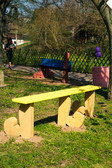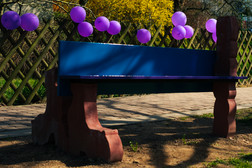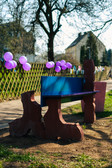Maruša Sagadin: Fast legs (Marjetka), Bad mood without kiosk and kitchen (Juliana Three-Legged)
Neukirchen / Ore Mountains
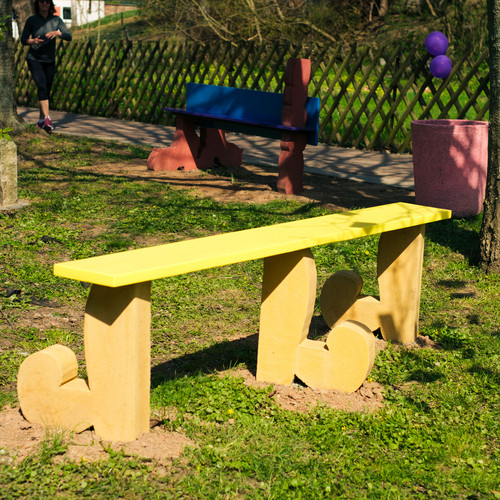
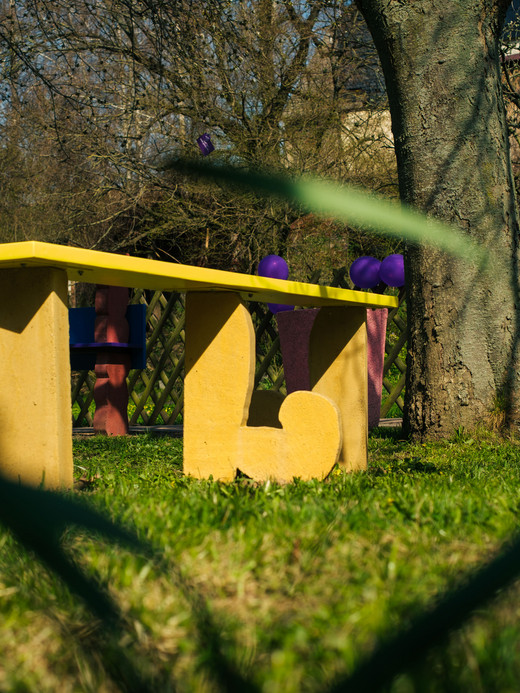
The two sculptures Juliana and Marjetka by the artist Maruša Sagadin, born in 1978 in Ljubljana/Slovenia, who now lives and works in Vienna/Austria, display playful humour in their cartoon-like forms. Who wouldn't want to take a seat on one of the objects made of concrete, wood and coloured paint? On a patch of grass where the rediscovered medieval pilgrimage route of the Saxon Way of St James makes a sharp turn in Adorf/Neukirchen, the artist cheerfully and cheerfully invites passers-by and residents alike to take a closer look at this place with her sculptures. With her sculptures, which reveal hints of feet or boots, and the use of bright colour, the artist invites viewers to discover and question social mechanisms, aesthetic codes and entrenched narratives in the social space of her installation site.
With their creative skills, their sensitivity to local history and regional customs, the citizens of Adorf have created a remarkable monument for themselves in their immediate neighbourhood based on a very similar impulse. Every year in the run-up to Christmas, a 6.40 metre high gable pyramid is erected and set in motion with a "manly march" by 24 Adorf residents dressed in the historical costumes of the pyramid figures. In the iconic formal language typical of the Ore Mountains, they convey the basis of their community: a deep and sensitive knowledge of specific stories, which they express in the special mixture of symbols, figures and colours from Christianity, the world of work and customs.
(Text: Alexander Ochs / Ulrike Pennewitz)
Maruša Sagadin
Fast legs (Marjetka), 2019
In Neukirchen
Material: concrete, pigments, wood, paint
Size: 125 x 167 x 95 cm
Maruša Sagadin
Bad mood without kiosk and kitchen (Juliana), 2020
In Neukirchen
Material: concrete, pigments, wood, paint
Size: 55 x 195 x 65 cm
Set up with the support of the municipality of Neukirchen / Erzgebirge.
Address:
Meadow area opposite Adorfer Hauptstraße 92
09221 Neukirchen/Erzgebirge
to the location on Google Maps
Neukirchen - Breaking new ground in the countryside
Neukirchen originated as a village of woodland hoofs in a settlement procession in the middle of the 12th century, like the neighbouring villages of Jahnsdorf and Amtsberg on the Purple Path. Neukirchen belonged to the fiefdom of the Benedictine monastery of Chemnitz. The monastery's register of interest records this as early as the 12th century and mentions the village as "innova ecla" (Latin abbreviation for nova ecclesia, i.e. new church).
Old and new ways
The town also developed thanks to its location near the old Franconian Road. Since the 13th century, the trade route from Bautzen in Upper Lusatia, where it branched off from the Via Regia, via Dresden, Freiberg and Chemnitz to Zwickau, where it met the Via Imperii, has been known as the Franconian Road. Today, the pilgrimage route runs along the historic Franconian Road Saxon Way of St James.
Renaissance: Klaffenbach moated castle
Agriculture, livestock farming, forestry and crafts dominated the village until the 19th century. The manor became the central economic centre from the 16th century onwards. The very wealthy mining master and mint master Wolf Hünerkopf from Annaberg bought the land from Chemnitz Monastery in 1543. A castle complex is subsequently built here.
The most striking part of the complex is the Renaissance-style moated castle. After several changes of ownership over the centuries, the neighbouring municipality of Klaffenbach acquired the Neukirchen castle and estate complex in 1926 and 1934. Today it is known as Klaffenbach moated castlea well-known event and cultural centre with a museum, hotel (****), golf course, creative studios and riding stables.
Textile industry and transformation
The textile industry gained a foothold in Neukirchen from the 1850s and remained an important employer until the early 1990s. The largest hosiery factory in the town was founded in 1877 and a large factory building was erected in 1903. However, no historical traces of this are visible, as today the "Sonnenhang" residential area is located on the site. Structural change and transformation are still issues that are relevant to Neukirchen today.
Communities in rural areas are constantly working on the quality of life, infrastructure and cultural life in order to offer their inhabitants new prospects for the future. Two examples of this are the Culinary Makerhub, a partner project of the Capital of Culture Chemnitz 2025, and the organic farm Gebrüder Bochmann, which offers exceptional overnight accommodation for pilgrims on the Way of St James.
Altars to kneel down to: Adorf/Erzgebirge parish
The Evangelical Lutheran church in the Neukirchen district of Adorf is located on the Way of St James between Chemnitz and Stollberg. The hall church with its south-east tower was built in 1909 in reform style architecture. It is not only a place of worship for the community and a place of devotion for pilgrims, but also an interesting place for visitors to the region. In addition to church services, religious festivals, choir and youth work, the events calendar also includes public concerts and meetings. The churchyard is home to the parish cemetery, a memorial to concentration camp prisoners who were victims of a death march and a war memorial to the fallen of the First World War.
The Saxon Way of St James and the Vogtland Way of St James run along the medieval Franconian Way through Saxony. Both routes are part of the European Way of St James network, which converges in St Jean-Pied-de-Port in France and leads from there to Santiago de Compostela (Spain). Marked throughout and equipped with pilgrims' accommodation, the Saxon route begins in Bautzen and leads along the Franconian Road through several towns on the Purple Path.
Other places on the Purple Path along the Way of St James are:
Flöha, Freiberg, Jahnsdorf, Oederan, Oelsnitz/Erzg., Stollberg, Zwickau
Making the future: A typical mentality in the Ore Mountains
Innovation and a sense of tradition, openness and immigration have always ensured the survival of the Erzgebirge mining region. All of this bears witness to the many transformation processes that reach far back into history and in some cases continue to this day. The region has always been on the move. People came and went with the economic ups and downs, reinvented themselves culturally and further developed crafts and technology. Sometimes people in one place simply changed industries in order to earn a living in a different way. This is still the case today.
Enjoyable exchange: Culinary Makerhub
An enjoyable exchange in the culinary Makerhub - what's behind this idea? The intention of this project of the Capital of Culture Chemnitz 2025 is to see opportunities as well as problems in the transformation of the local economy. For example, it is about replacing the use of vacant buildings, in this case an old car dealership in Neukirchen. What else can be done with it - apart from demolition?
The KREATIVES SACHSEN initiative, a partner of the Capital of Culture Chemnitz, brought together expertise from the fields of gastronomy, architecture, woodworking, event management, interior design, education, youth work and the creative industries in the car dealership back in 2023. In an intensive prototyping process, the location took an important step towards the transformation of the site.
This gave rise to the idea of cooking together and exchanging flavours with European guests. In close connection with local products and traditions, very special relationships could be created in the Culinary Makerhub - during and after the Capital of Culture year 2025. The first cookery events are already being planned.
The sculptures that Maruša Sagadin designed and created for the Purple Path are located in the entrance area. They can be used as benches to sit on and invite you to linger. This creates a new kind of place for encounters and communication.
For the Capital of Culture Bad Ischl Salzkammergut 2024 the artist Maruša Sagadin redesigned the foyer of the Alte Post with her playful, subversive sculptures.
Overnight stay in a covered wagon and Tiny House project: Bochmann brothers' organic farm on the Way of St James
In the year 2023 the GEO magazine magazine, which reported on unusual pilgrim hostels along the German Way of St James. One section was dedicated to Bert and Tilo Bochmann. They run an organic farm in Neukirchen, which is located directly on the pilgrims' route. Pilgrims can spend the night here in hay on a covered wagon. There is also a stamp station at the farm.
The farm will literally have to break new ground in the future. In the summer of drought in 2018, the brothers had to stop dairy farming with a heavy heart. As pilgrimages are in vogue, the Bochmanns now want to focus entirely on pilgrims. The location of the farm directly on the pilgrimage route and the nearby St Michael's Church offer the best conditions for this. Further accommodation is being planned. The resourceful farmers have sought creative partners for this.
One of them is Jacob Strobel, Professor of Wood Design at the Schneeberg Faculty of Applied Arts at the West Saxon University of Applied Sciences in Zwickau. He will build the prototype of a Tiny House with his students and in constant dialogue with the Bochmanns. The Capital of Culture Chemnitz 2025 is supporting this project.
